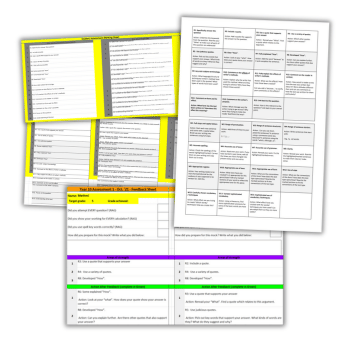Teacher workload – Smart strategies for faster and more effective marking

Bhamika Bhudia offers some suggestions for tackling those marking demands in a less labour-intensive way…

- by Bhamika Bhudia
- Head of English and writer of bilingual children's books Visit website

Haunting every practitioner is the spectre of unmarked books, incomplete assessments and ungraded homework tasks. No matter how organised you are, you know that such tasks will never be fully ‘finished’.
With so much required of practitioners in their day-to-day teaching, it’s thus inevitable that book scrutinies and surprise assessment-focused learning walks will often cause resentment. Unmarked books leave us open to criticism and the feeling that we aren’t doing our jobs adequately – despite investing countless hours in planning, contacting homes, emails, training, and many other teaching and learning responsibilities.
What gets lost amid all this, however, is the actual purpose of marking. It’s not there to make books look pretty, prove we’re doing our jobs and let us tick the right boxes. Marking student work is an incredibly valuable tool for facilitating long-term progress.
As well as helping teachers better understand their students’ needs, it helps students themselves better understand how to move forward and improve the quality of their work. The need for marking isn’t going away anytime soon – and if it helps students progress, nor should it. But we can manage our marking in a more time-efficient and meaningful way.
The planning process
‘Ticking and flicking’ has long been recognised as an inefficient use of teacher time, since it doesn’t allow students to act on the feedback they receive or understand how to improve.
No matter how beautiful those books look, if they can’t guide students forward, it’s just precious time wasted. Seen in this light, marking because you haven’t looked at student books for a while can be fruitless. Unless it’s in line with your scheme of learning’s objectives or students’ long-term goals, you run the risk of investing time for no real benefit.
Additionally, with exam classes now undergoing more assessment and data entry points, your remaining classes – particularly at KS3 – can end up at the bottom of your priority list. Chances are, they’ll be well-represented among those books that go for weeks without being looked at, the window for valuable feedback opportunities having long since closed.
A simple grid
One labour-efficient way of tackling this is to decide what should be marked alongside your lesson planning. This needn’t require any major adjustments to what most teachers already do, nor will it entail any huge organisational upsets.
All it takes a simple grid containing all classes taught. These can be filled in during the lesson planning process, highlighting marking opportunities that will develop key skills or understanding within the unit being taught, before then being ticked off when completed.
This is a quick and easy way of making sure certain classes aren’t forgotten about, and that surprise book scrutinies aren’t met with heart palpitations. The more you treat marking as an adjunct, or even afterthought within teaching, the more redundant and burdensome it’s likely to become.
Another reason for marking being seen as one of the worst parts of the job is its sheer mundanity. It requires considerable time, and tends to be a mostly repetitive process that involves writing the same things out over and over again in different students’ books.
What we need are time-saving strategies that can be relied upon once common strengths and errors have been properly identified.
Marking codes
For subjects requiring the same set of skills to be demonstrated across the board, coded marksheets can be stuck in student books. Consider the lengthy ‘WWW: You have started to explain your argument’ and ‘EBI: Comment on the effects of writer’s methods’ – both can be shortened to ‘WWW: Good R6’ and ‘EBI: R10’. Not only will this save time in writing your feedback, it also makes thinking of appropriate feedback that much easier, since there are always go-to examples to hand.
By keeping marksheets inside students’ books, you can be sure that they’ll all have an accessible success criteria to refer to when completing future work. These marksheets can also provide valuable guidance for students on how to act on the feedback they receive, rather than simply identifying strengths and weaknesses.
Whole class feedback
Whole class feedback is an excellent strategy for addressing misconceptions in whole groups and informing future planning. Give students sheets containing overall successes and areas for development, alongside guidance on which are applicable to individual students, a section for student praise and space for a model example.
This is a huge time-saver. It can help you assess the progress of the class as a whole, while also being something students can refer back to when developing future work. It can even be used to configure seating plans, when considering how different student strengths can complement each other.
Spreadsheets
Another approach that minimises rewriting is to use formulated spreadsheets. Teachers can quantify common strengths and weaknesses, and assign individual students specific targets by entering the relevant numbers. The formula will then generate the feedback, saving you the time of continually rewriting it.
These can vary in complexity. For example, you can go with a comparatively simple ‘What Went Well’ and ‘Even Better If’ setup, where inputs can be entered into a table that’s then printed off and cut into small strips that are handed out to students.
At the other end of the scale are sophisticated spreadsheets capable of automatically submitting student targets, indicating how close students are to reaching them and highlighting strengths and weaknesses within students’ work. These can be used to create assessment feedback sheets for printing out and sticking into students’ books, making student feedback consistent and quick, while demanding minimal writing on the part of teachers.
Taking it forward
Yet even with the aid of these and other time- saving processes, marking tasks still entail considerable time investment – so make sure it’s time well spent. Marking should never involve more input than output. Creating processes where students are able to use prior feedback to develop future work will aid their long-term progress – particularly when their marked work has been carefully considered, rather than decided on a whim.
Simple and resource-light strategies in this vein can include having students look through books and answering the prompt, ‘My last EBI was…’ before an assessment, or as they plan for it. If you’re using coded marksheets, get students to add stars as they receive new EBIs to see if they’re continuing to make the same mistakes. They can then apply this guidance to their work independently.
You could also arrange for blank grids to be stuck in books, into which students copy out feedback to help track their progress. Over time, this will provide them with an easily-accessible sheet of prior teacher feedback they can use to remind themselves of previous errors, and thus hopefully avoid making them again. Wherever possible, feedback should carry long-term impact and ultimately build more independent learners.
Marking will always be a difficult part of the job, but with the right systems and strategies, you can save yourself countless hours and stress. Above all, see it for what it actually is – a process that helps teachers and students progress – rather than busywork to satisfy the higher-ups.
See it in practice
Sample marksheet A sample marksheet designed to facilitate the marking process and help guide students towards meeting specific success criteria in English
Whole class feedback form A whole class feedback form pertaining to a Y11 lesson on Shakespeare’s Macbeth, compiling WWW/EBI, praise criteria, AAF tasks and an illustrative ‘Wow’ moment
Criteria / Marking / Printing An editable Y10 Assessment spreadsheet with embedded instructions and accompanying ‘marking’ and ‘printing’ sheets
Bhamika Bhudia is a teacher of English and lead teacher in a mixed comprehensive secondary school in London; follow her at @MissMika_Eng







